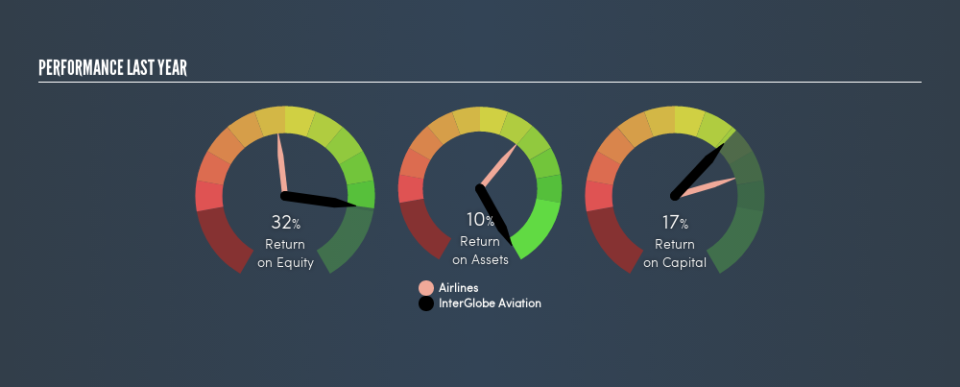Are InterGlobe Aviation Limited’s (NSE:INDIGO) High Returns Really That Great?

Today we are going to look at InterGlobe Aviation Limited (NSE:INDIGO) to see whether it might be an attractive investment prospect. To be precise, we’ll consider its Return On Capital Employed (ROCE), as that will inform our view of the quality of the business.
First of all, we’ll work out how to calculate ROCE. Second, we’ll look at its ROCE compared to similar companies. Finally, we’ll look at how its current liabilities affect its ROCE.
Return On Capital Employed (ROCE): What is it?
ROCE is a metric for evaluating how much pre-tax income (in percentage terms) a company earns on the capital invested in its business. In general, businesses with a higher ROCE are usually better quality. Ultimately, it is a useful but imperfect metric. Renowned investment researcher Michael Mauboussin has suggested that a high ROCE can indicate that ‘one dollar invested in the company generates value of more than one dollar’.
How Do You Calculate Return On Capital Employed?
The formula for calculating the return on capital employed is:
Return on Capital Employed = Earnings Before Interest and Tax (EBIT) ÷ (Total Assets – Current Liabilities)
Or for InterGlobe Aviation:
0.17 = ₹26b ÷ (₹211b – ₹61b) (Based on the trailing twelve months to March 2018.)
So, InterGlobe Aviation has an ROCE of 17%.
Check out our latest analysis for InterGlobe Aviation
Want to participate in a research study? Help shape the future of investing tools and earn a $60 gift card!
Is InterGlobe Aviation’s ROCE Good?
One way to assess ROCE is to compare similar companies. Using our data, we find that InterGlobe Aviation’s ROCE is meaningfully better than the 12% average in the Airlines industry. We would consider this a positive, as it suggests it is using capital more effectively than other similar companies. Independently of how InterGlobe Aviation compares to its industry, its ROCE in absolute terms appears decent, and the company may be worthy of closer investigation.
When considering ROCE, bear in mind that it reflects the past and does not necessarily predict the future. ROCE can be misleading for companies in cyclical industries, with returns looking impressive during the boom times, but very weak during the busts. ROCE is, after all, simply a snap shot of a single year. Since the future is so important for investors, you should check out our free report on analyst forecasts for InterGlobe Aviation.
InterGlobe Aviation’s Current Liabilities And Their Impact On Its ROCE
Short term (or current) liabilities, are things like supplier invoices, overdrafts, or tax bills that need to be paid within 12 months. The ROCE equation subtracts current liabilities from capital employed, so a company with a lot of current liabilities appears to have less capital employed, and a higher ROCE than otherwise. To counter this, investors can check if a company has high current liabilities relative to total assets.
InterGlobe Aviation has total assets of ₹211b and current liabilities of ₹61b. Therefore its current liabilities are equivalent to approximately 29% of its total assets. Current liabilities are minimal, limiting the impact on ROCE.
What We Can Learn From InterGlobe Aviation’s ROCE
This is good to see, and with a sound ROCE, InterGlobe Aviation could be worth a closer look. You might be able to find a better buy than InterGlobe Aviation. If you want a selection of possible winners, check out this free list of interesting companies that trade on a P/E below 20 (but have proven they can grow earnings).
If you like to buy stocks alongside management, then you might just love this free list of companies. (Hint: insiders have been buying them).
We aim to bring you long-term focused research analysis driven by fundamental data. Note that our analysis may not factor in the latest price-sensitive company announcements or qualitative material.
If you spot an error that warrants correction, please contact the editor at editorial-team@simplywallst.com. This article by Simply Wall St is general in nature. It does not constitute a recommendation to buy or sell any stock, and does not take account of your objectives, or your financial situation. Simply Wall St has no position in the stocks mentioned. Thank you for reading.

